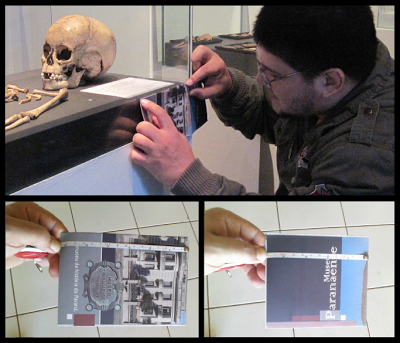ATOR (Arc-Team Open Research). The blog spreads tests, problems and results of Arc-Team research in archaeology, following the guidelines of the OpArc (Open Archaeology) project.
Saturday, 1 June 2013
Forensic facial reconstruction of an aboriginal child from Brazil
Since I started to study forensic facial reconstruction, rarely I saw the real skull in front of my eyes.
Some days ago, when I went to Curitiba city, to make some talks and start the exhibition Faces of Evolution I saw the replicas of the hominids that we reconstructed the faces here in ATOR. Including, a replica of the Taung Child.
During this visit, the archaeologist Dr. Moacir Elias Santos and Dr. Liliane Cristina Coelho invited me to know the Paranaense Museum, where we took some fotos and I saw the real bones of a Brazilian aboriginal child.
Taking advantage of his know-how of 3D scanning by photos, Dr. Moacir Elias Santos took some photos of the aboriginal child with a good simple camera without flash, and without move the object.
Even with a low-illuminated scene, the photos had a good quality to be scanned.
Even though the scanning technique works well, it lacks an automated scaling system. To solve this problem I used an folder that Paranaense Museum offer to the visitants. I made the measure folding it with the dimensions of the legend of the bones. After, I used it to get the dimensions with a measuring tape.
The scanning worked well on PPT-GUI. The points cloud had a good quality to be converted in a mesh.
Although the quality was good, the side of the skull that pointing to the wall wasn't reconstructed completely.
To solve this problem I mirrored the mesh on Blender.
And I erased the overlapping vertices.
The following step was put the tissue depth markers second Manheim et al. (2000). We choose the column of 8 years because the researchers said that the child was 7 or 9 years old.
With the tissue depth markers placed, It was possible trace the lateral shape of the face.
To make the facial muscles I used a pre-modeled muscles from other reconstruction and I deformed it to match with the skull.
The same process was used with the skin. It started with a pre-modeled mesh.
And it was deformed until match with the tissue depth and the muscles.
The following step consisted to sculpt the details on the face surface. The eyes was setted with asiatic characteristics second the observations of Dr. Paulo Miamoto, a doctoral student of forensic sciences.
Because we didn't have the information about the sex of the child I made a neutral reconstruction. In the final, the image illustrate a child with asiatic characteristics.
I hope you enjoyed.
A big hug!
Subscribe to:
Post Comments (Atom)















No comments:
Post a Comment